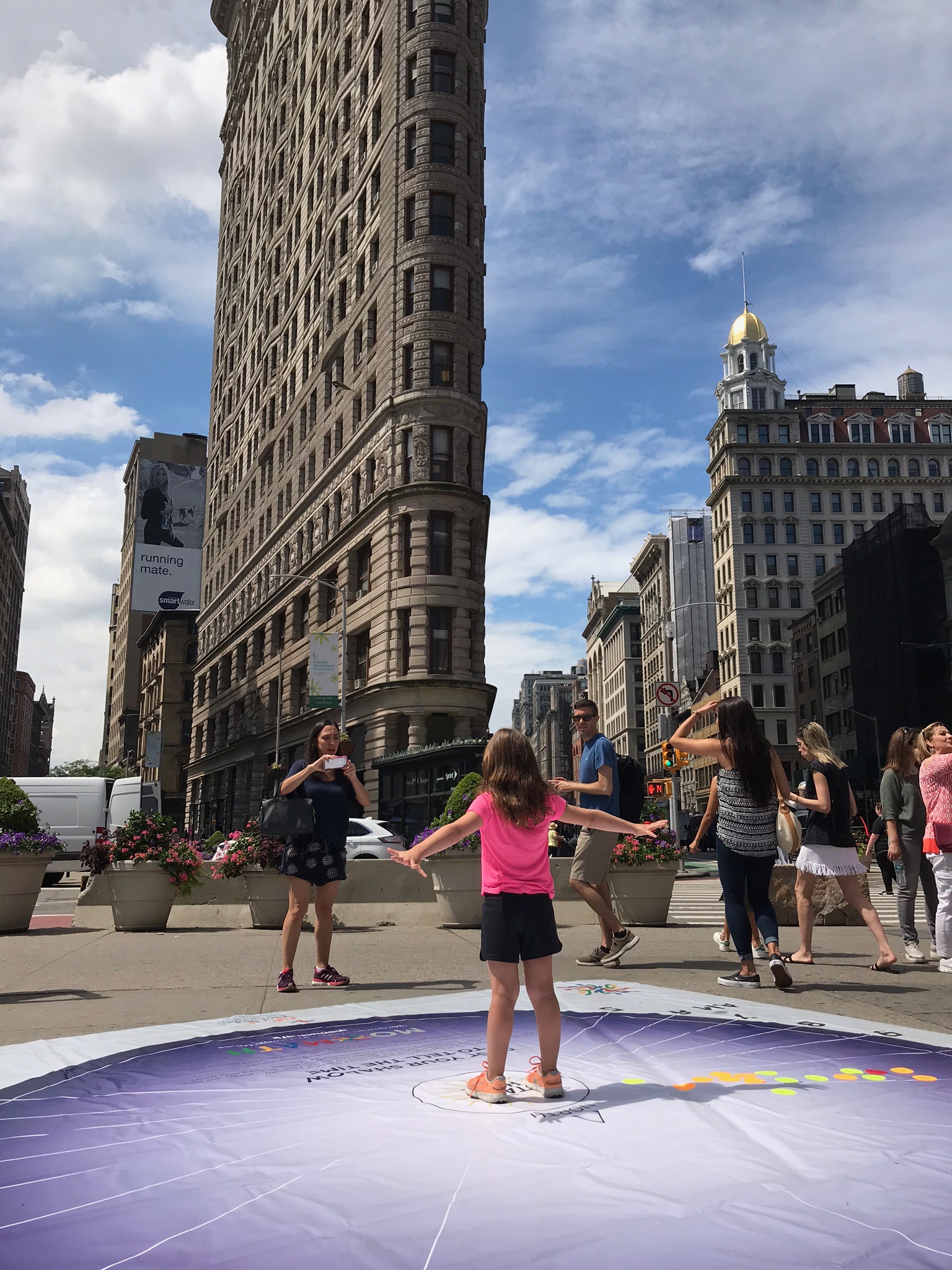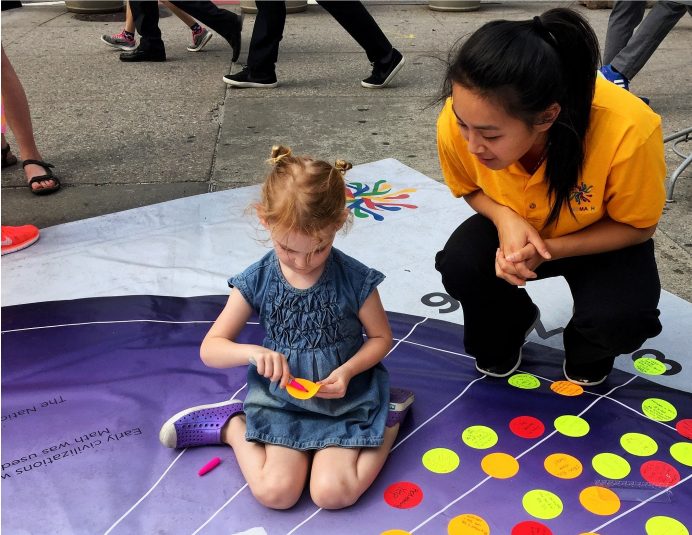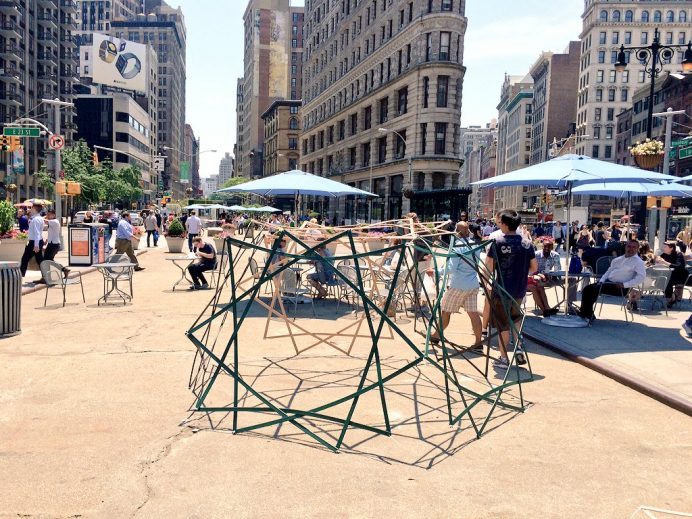MathHappenings
MathHappenings are public engagement events designed by the National Museum of Mathematics to celebrate the wonder and beauty of mathematics.
Brooklyn Bridge
MoMath plans to host a public event at the Brooklyn Bridge, an iconic NYC landmark and a magnificent display of the power of parabolas. Do you have an idea for a fun event celebrating the Bridge, math, and MoMath? Email it to brooklynbridge@momath.org — you just might see your idea come to life!

Graph the Grid 2021
May 1, 2021 — MoMath invited New Yorkers to help create a human graph across the Manhattan grid by becoming points along an elegant parabolic curve. Participants shared their locations on social media and watched the magic unfold as together we built a human-scale graph of a quaint quadratic function. Brought to you through the joint efforts of MoMath, the nation’s only Museum of Mathematics, and Mathigon, creator of innovative new online math curricula, this event provided a moment of collaboration and community for all. See more at grid.momath.org.

Solstice Reflections 2019
December 17, 2019 — In celebration of the season of light, MoMath invited passersby to experience the joyful reflection of a life-sized kaleidoscope while enjoying a hot beverage and a tasty snack provided by our friends from the Flatiron Business Improvement District.
ngg_shortcode_0_placeholder
Million Millimeter March for MoMath
MoMath welcomed its one millionth visitor in June 2019! The Museum marked this auspicious occasion with the Million Millimeter March for MoMath, beginning at 6:00 pm on 6/6, in honor of reaching visitor number 106. Hundreds of MoMath enthusiasts received commemorative T-shirts and embarked on a one-million-millimeter walk through the neighborhood, meeting some interesting characters (and some interesting numbers!) along the way. The last stop was a party in the Museum, where participants celebrated with pizza, dancing, and prizes for the best in geek chic attire. See more at million.momath.org.
Experience more of the march with YouTuber Tom Crawford, AKA Tom Rocks Math (@tomrocksmath), and puzzle master Peter Winkler’s commentary in Tom’s video of the march at tom.momath.org.

Solstice Sundial 2019
June 21, 2019 — Passersby on the Flatiron Plaza in Madison Square cast their shadows to mark the time on the longest day of the year. Participants joined MoMath in creating a large-scale human sundial and left their personal marks on a giant sundial banner.
Solstice Reflections 2018
December 17, 2018 — In celebration of the season of light, MoMath partnered with the Flatiron Business Improvement District to bring the joyful reflection of a life-sized kaleidoscope to the Flatiron Public Plaza in Madison Square. In preparation for the shortest day of the year, participants snapped selfies of their own images reflected in multiple ways.
Solstice Sundial 2018
June 21, 2018 — Together with the Flatiron Business Improvement District, MoMath brought a large-scale human sundial to the Flatiron Public Plaza in Madison Square. On the longest day of the year, participants traced the passage of the hours with the cast of their own shadows and the help of MoMath’s pavement-top sundial banner.
Solstice Spirals 2017
December 21, 2017 — Passersby on the Flatiron Plaza in Madison Square joined MoMath and the Flatiron Partnership to celebrate the winter solstice with a giant group construction of Solstice Spirals, a reflective dynamic sculpture. In this Fibonacci-inspired design (based on the work of John Edmark), every piece is exactly the same shape, but each consecutive piece is slightly different in size. Participants started assembling this kinetic sculpture with the tiniest piece and witnessed how quickly the pieces grew as we used the golden angle to build a pattern found in sunflowers, pinecones, and roses.

Pythagorize Seattle
August 15, 2017 — MoMath returned to Seattle for a second year to celebrate Pythagoras Day 2017 — the last (primitive) Pythagorean triple until 2024! Made possible by the Bezos Family Foundation, OppenheimerFunds, and Weyerhaeuser, the event unfolded in multiple stages, featuring a city-wide puzzle hunt designed by Lone Shark Games to engage individuals, groups, and families.
ngg_shortcode_1_placeholder
Solstice Sundial 2017
June 21, 2017 — Passersby on the Flatiron Plaza in Madison Square cast their shadows to mark the time on the longest day of the year. Participants joined MoMath in creating a large-scale human sundial and left their personal marks on a giant sundial banner that was later displayed in the nation’s only Museum of Mathematics through the end of the month.
Solstice Poly-star 2016
June 20, 2016 — MoMath celebrated the mathematical significance of the summer solstice in New York City on the Flatiron Plaza at 23rd St. and Broadway. There, passersby shared in mathematical beauty inspired by the start of summer and learned why, just as a seven-pointed star perfectly suits the winter solstice, a ten-pointed star captures the math of the opposite extreme of the solar year. And this time, MoMath took the celebration into the third dimension — participants constructed a dozen ten-pointed stars and assembled them into an almost ten-foot-tall geometric structure with remarkable symmetry.
Fractal Fun at the World Science Festival
June 4, 2016 — MoMath partnered with the World Science Festival and 144 volunteers to construct a giant glowing fractal! MoMath’s rainbow-colored lightsticks were used to create a human-scale Koch snowflake in Brooklyn Bridge Park in what became the world’s largest-ever human fractal demonstration.
A Random Walk on Wall Street
May 11, 2016 — Dice rolls, small steps, and a giant group march culminate in a surprising result: a huge human histogram showing the famous “normal curve” of statistics.
Pi Day 2016
March 14, 2016 — MoMath’s celebration of Pi day on 3/14/16 was a great success. The event marked the date in the entire century that most closely approximates pi to the ten-thousandths position (3.1416).
The morning began with Meaning of Pi, an audience-participatory demonstration that brought to life what pi is, what it does, and how we know about it, using MoMath’s Square-Wheeled Trike exhibit.
At 11:30 am, participants headed outside for Rhythmic Rotations, a hula-hooping contest in honor of pi, the circular constant. The hoops were huge! Check out the amazing video to watch a few brave New Yorkers take on the Huge (11.5 foot!) Hula challenge: hula.momath.org.
Next was a group build of Apollonian Apertures, the 9-foot fractal circles-within-circles sculpture that represents a minor miracle of mapmaking. See photos of the completed structure below.
The afternoon featured Tetsuya Miyamoto, the brilliant inventor of KenKen®, who shared the secrets that led to the creation of KenKen and and invited participants to try their hands at a series of challenging new hand-crafted KenKen puzzles.
ngg_shortcode_2_placeholder
Solstice Stars 2015
December 22, 2015 — Thanks to everyone who helped make Solstice Stars a smashing success! Over 350 participants created an amazing 20-meter heptagram to commemorate the geometry of the winter solstice in New York City (see the video from the top of the Flatiron).
You may be wondering, “Why a heptagram?” Consider the geometry of the solar system. At noon on the equinox at the equator, the sun is directly overhead; in other words, it makes a 90° angle with the horizon. As you move to higher latitudes, however, the greatest altitude of the sun decreases by one degree for each degree of latitude that you travel. Hence in New York City, at 40.7° latitude, the highest that the sun reaches in the sky on the equinox is an angle of 49.3° above the horizon (49.3 because 90 – 40.7 = 49.3). Now, if the axis of rotation of the Earth were perpendicular to the plane of the solar system, that would be the whole story. But as the fact that we have seasons tells us, and as illustrated in the bottom right picture below, that axis of rotation is actually tilted — by 23.5°. Therefore, when the hemisphere you’re in is tilted toward the sun (summer), the sun appears higher in the sky; and when it’s tilted away from the sun, the sun appears lower. This event took place on 2015 December 22, the winter solstice, when the Earth’s axis of rotation points directly away from the sun in the Northern hemisphere, and so the sun’s highest point in the sky for the day is the lowest of any day in the year: only 49.3° – 23.5° = 25.8°.
That’s where the heptagram comes in. The points of a heptagram divide the circle into seven equal parts. But the angle at each point is half of that, because an inscribed angle is half of a central angle. So the angle at each point of a heptagram is 360°/(2*7) = 25.7°. Since the angle of the points of a heptagram is within a tenth of a degree of the highest point the sun achieved over New York City on the solstice, MoMath thought that bringing hundreds of people together to create a glowing heptagram would be a great way to observe the solstice.
Pythagorize Seattle
August 17, 2015 — On Pythagoras Day 2015, MoMath and the Pacific Science Center brought an all-new MathHappenings to the city of Seattle! This collaboration took place in honor of Seattle’s historic Triangle Pub. The Triangle Pub was selected from triangular buildings around the country because its dimensions are 8 meters x 15 meters x 17 meters — a Pythagorean triple that just happened to correspond with the date.
Hundreds of Seattle-based math lovers flocked to Lake Union Park on 8/17/15 to become part of the nation’s largest-ever human illustration of the Pythagorean Theorem. Enjoy the pictures below and lyrics of Pythagorize With Me, which was sung to celebrate this collective achievement.
Thank you to everyone who helped make Pythagorize Seattle the biggest mathematics demonstration Seattle has ever seen!
ngg_shortcode_3_placeholder
Pi Day of the Century
March 14, 2015 — Hundreds of New Yorkers created two giant circles with MoMath’s signature glowing light sticks to discover the beautiful recurrence of pi among circles of all sizes. Then, a Pi Countdown clock ticked down the time until 53 seconds past 9:26 pm (that’s 3.14.15.9.26.53). Read more at momath.org/pi-day-2015.

Pythagorize the Flatiron
December 5, 2013 — Pythagorize the Flatiron, the first in MoMath’s series of MathHappening events, was a great success! It was wonderful to see so many people showing their enthusiasm for mathematics at the largest public math demonstration in New York’s history. Enjoy the pictures below, and see more fun Pythagoras facts at pythagorizefacts.momath.org. Thank you to everyone who participated!
You can read more about the event here: pythagorize.momath.org.
Los Angeles Times, Some squares sum squares to celebrate Pythagoras (December 5, 2013)
TIME, Hey, Math Nerds: Today’s Date Is a Pythagorean Triple (December 5, 2013)
Popular Mechanics, A Pythagorean Party at the Flatiron Building (December 6, 2013)
Business Insider, 500 Lightstick-Toting Math Enthusiasts ‘Pythagorized’ NYC’s Iconic Flatiron Building In Epic Fashion (December 6)
Condé Nast Traveler, NYC’s Flatiron Building Becomes a Monument to Math (December 6, 2013)
Scientific American, Glow Sticks Prove the Math Theorem behind the Famous Flatiron Building (December 11, 2013)
Watch highlights from Pythagorize the Flatiron on MoMath’s YouTube channel.




















